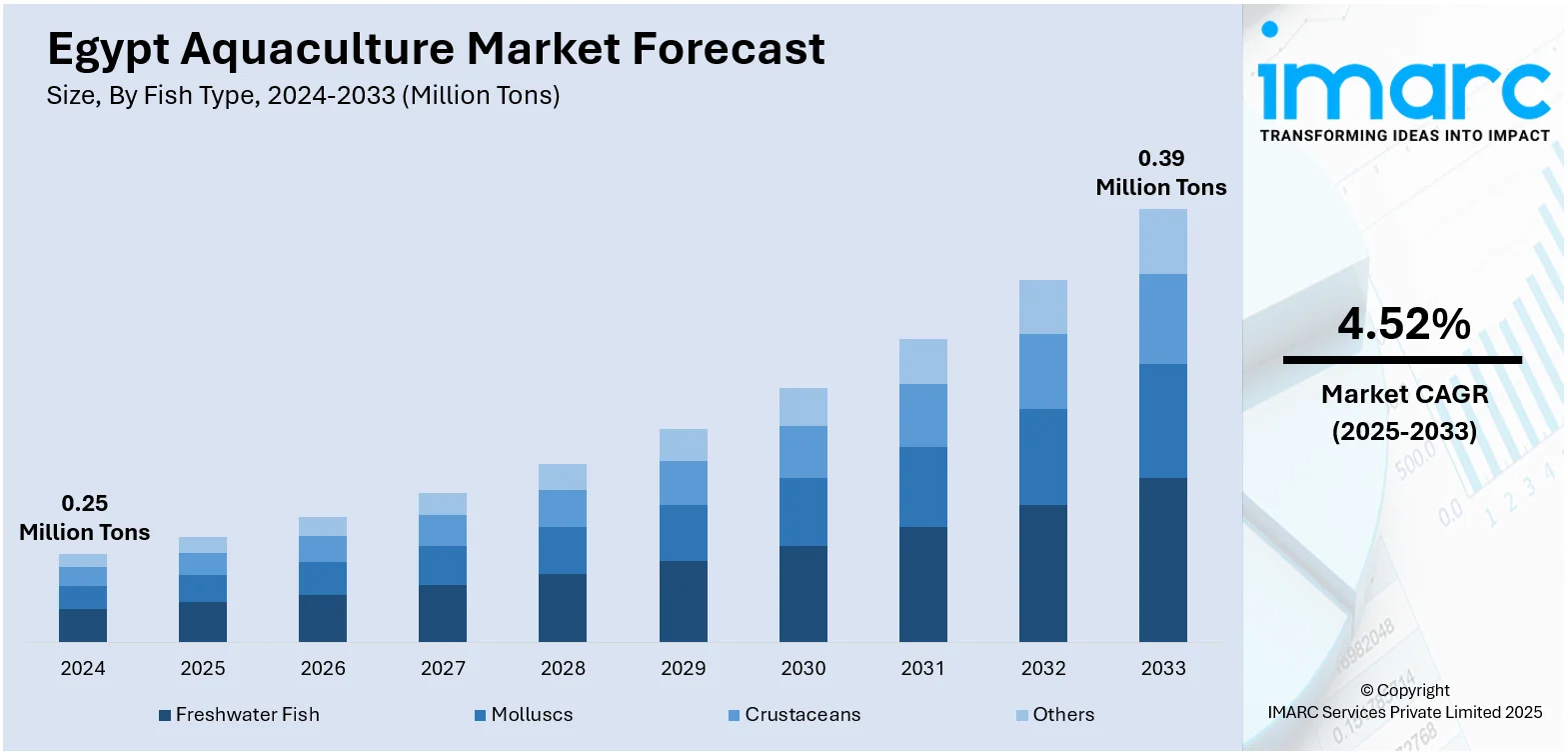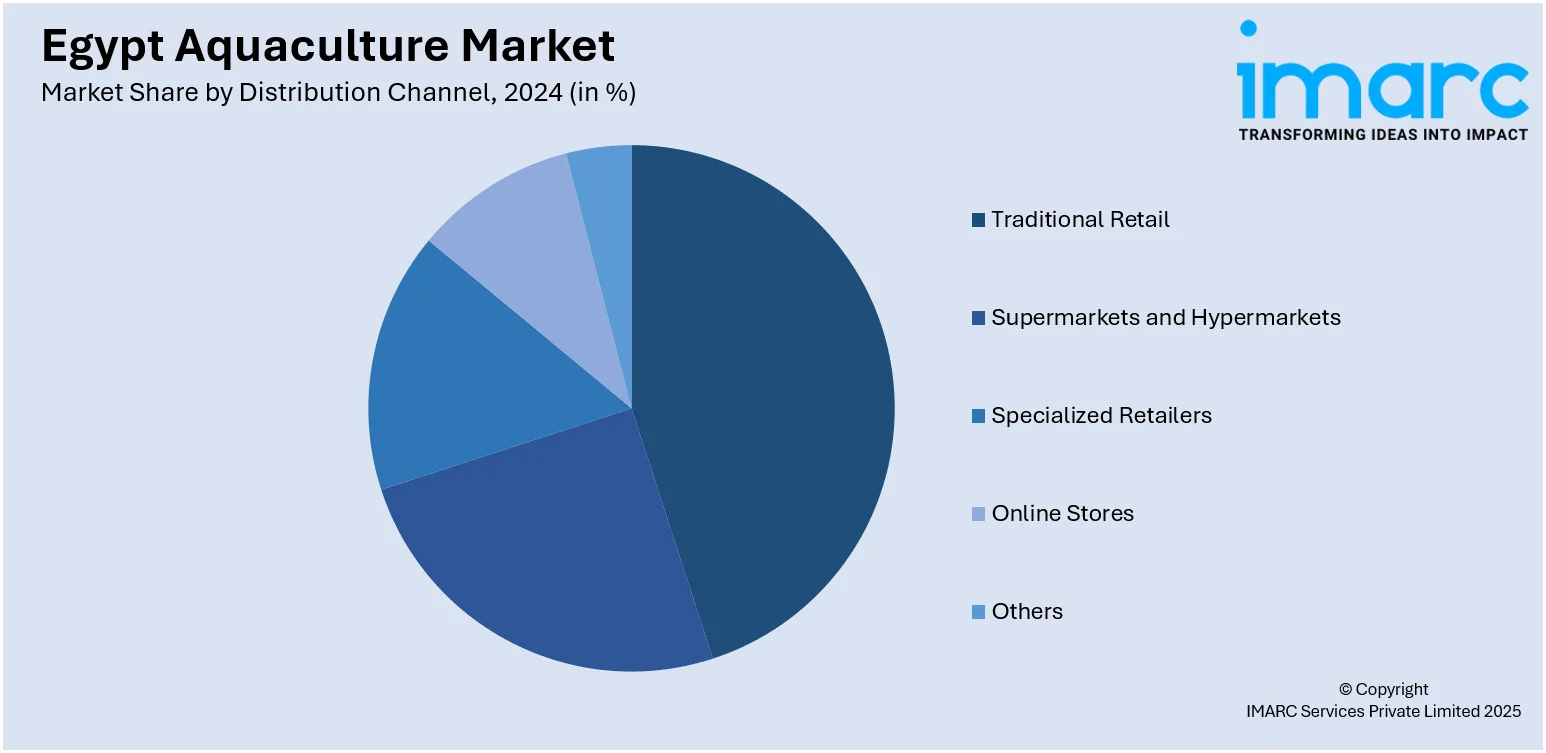
Egypt Aquaculture Market Size, Share, Trends and Forecast by Fish Type, Environment, Distribution Channel, and Region, 2025-2033
Egypt Aquaculture Market Overview:
The Egypt aquaculture market size reached 0.25 Million Tons in 2024. Looking forward, the market is projected to reach 0.39 Million Tons by 2033, exhibiting a growth rate (CAGR) of 4.52% during 2025-2033. The market is supported by its favorable climate, availability of brackish water, rising domestic fish consumption, and government initiatives to reduce seafood imports. Investments in feed quality, disease management, and hatchery infrastructure further strengthens Egypt aquaculture market share.
|
Report Attribute
|
Key Statistics
|
|---|---|
|
Base Year
|
2024
|
|
Forecast Years
|
2025-2033
|
|
Historical Years
|
2019-2024
|
| Market Size in 2024 | 0.25 Million Tons |
| Market Forecast in 2033 | 0.39 Million Tons |
| Market Growth Rate 2025-2033 | 4.52% |
Egypt Aquaculture Market Trends:
Nile Tilapia Dominance
Nile tilapia remains the cornerstone of Egypt’s aquaculture production, accounting for a significant portion of total farmed fish output. The species thrives in the country's warm water conditions and has high feed conversion efficiency. The government and private sector are working to improve genetic stock and disease resistance to increase productivity. Efforts are also underway to expand tilapia farming into desert and saline water zones using recirculating aquaculture systems (RAS). By focusing on the species’ scalability and export potential, Egypt is consolidating its leadership in regional aquaculture. The dominance of tilapia, backed by strong supply chains and consumer acceptance, continues to play a crucial role in driving Egypt aquaculture market growth. For instance, the Tilapia Welfare Egypt Project improved the welfare of over 260 million Nile tilapia, about 10% of Egypt’s farmed fish. Launched in 2024 by Ethical Seafood Research, FAI Farms, and Aquavet Egypt, it provided training and an app to help farmers monitor water quality, reduce mortality, and cut costs. Over 1,000 farms and 150 welfare educators benefited, with nearly 4,000 welfare assessments completed. The project boosts fish health, farm profitability, and industry standards in Egypt’s major tilapia regions.

To get more information on this market, Request Sample
Public-Private Collaborations
Egypt’s aquaculture development is increasingly shaped by collaborations between government bodies, international NGOs, and private investors. These partnerships focus on training farmers, improving hatchery management, and ensuring quality feed supply. Public agencies are also facilitating access to land and licenses, reducing bureaucratic hurdles for aquaculture entrepreneurs. These collaborative efforts aim to increase sector resilience, particularly among small and medium-sized producers. By improving value chains and addressing structural inefficiencies, such partnerships are significantly contributing to Egypt aquaculture market growth, making the sector more competitive both regionally and globally. For instance, in November 2024, Egypt and Liberia signed an MOU to boost cooperation in aquaculture, focusing on sustainable development, governance, combating illegal fishing, research, and trade. The deal supports African economic integration and aligns with Liberia’s ARREST agenda. Egypt pledged technical support and training, leveraging its Mediterranean and Red Sea experience. The agreement reflects Egypt’s commitment to African partnerships, food security, and raising living standards.
Egypt Aquaculture Market Segmentation:
IMARC Group provides an analysis of the key trends in each segment of the market, along with forecasts at the region/country level for 2025-2033. Our report has categorized the market based on fish type, environment, and distribution channel.
Fish Type Insights:
- Freshwater Fish
- Molluscs
- Crustaceans
- Others
The report has provided a detailed breakup and analysis of the market based on the fish type. This includes freshwater fish, molluscs, crustaceans, and others.
Environment Insights:
- Fresh Water
- Marine Water
- Brackish Water
A detailed breakup and analysis of the market based on the environment have also been provided in the report. This includes fresh water, marine water, and brackish water.
Distribution Channel Insights:

- Traditional Retail
- Supermarkets and Hypermarkets
- Specialized Retailers
- Online Stores
- Others
The report has provided a detailed breakup and analysis of the market based on the distribution channel. This includes traditional retail, supermarkets and hypermarkets, specialized retailers, online stores, and others.
Regional Insights:
- Greater Cairo
- Alexandria
- Suez Canal
- Delta
- Others
The report has also provided a comprehensive analysis of all the major regional markets, which include Greater Cairo, Alexandria, Suez Canal, Delta, and others.
Competitive Landscape:
The market research report has also provided a comprehensive analysis of the competitive landscape. Competitive analysis such as market structure, key player positioning, top winning strategies, competitive dashboard, and company evaluation quadrant has been covered in the report. Also, detailed profiles of all major companies have been provided.
Egypt Aquaculture Market News:
- In April 2025, Egypt’s Suez Canal Aquaculture Company signed a cooperation MOU with Spain’s Tejedor Lázaro Group to boost fisheries and aquaculture. The deal aims to enhance food security, attract foreign investment, and develop sustainable aquaculture projects, aligning with Egypt’s strategy to expand the sector and strengthen ties with Spain.
- In April 2024, the U.S. Soybean Export Council (USSEC), USDA, and WorldFish collaborated in Egypt to advance sustainable aquaculture. Their Soy Excellence Center in Abbassa offered training in marine fish hatchery management, supporting Egypt, the largest African aquaculture producer, and the MENA region. This initiative promoted climate-smart practices, food security, and economic growth through education, innovation, and cross-sector partnerships, addressing climate challenges and a rising global population.
Egypt Aquaculture Market Report Coverage:
| Report Features | Details |
|---|---|
| Base Year of the Analysis | 2024 |
| Historical Period | 2019-2024 |
| Forecast Period | 2025-2033 |
| Units | Million Tons |
| Scope of the Report |
Exploration of Historical Trends and Market Outlook, Industry Catalysts and Challenges, Segment-Wise Historical and Future Market Assessment:
|
| Fish Types Covered | Freshwater Fish, Molluscs, Crustaceans, Others |
| Environments Covered | Fresh Water, Marine Water, Brackish Water |
| Distribution Channels Covered | Traditional Retail, Supermarkets and Hypermarkets, Specialized Retailers, Online Stores, Others |
| Regions Covered | Greater Cairo, Alexandria, Suez Canal, Delta, Others |
| Customization Scope | 10% Free Customization |
| Post-Sale Analyst Support | 10-12 Weeks |
| Delivery Format | PDF and Excel through Email (We can also provide the editable version of the report in PPT/Word format on special request) |
Key Questions Answered in This Report:
- How has the Egypt aquaculture market performed so far and how will it perform in the coming years?
- What is the breakup of the Egypt aquaculture market on the basis of fish type?
- What is the breakup of the Egypt aquaculture market on the basis of environment?
- What is the breakup of the Egypt aquaculture market on the basis of distribution channel?
- What is the breakup of the Egypt aquaculture market on the basis of region?
- What are the various stages in the value chain of the Egypt aquaculture market?
- What are the key driving factors and challenges in the Egypt aquaculture market?
- What is the structure of the Egypt aquaculture market and who are the key players?
- What is the degree of competition in the Egypt aquaculture market?
Key Benefits for Stakeholders:
- IMARC’s industry report offers a comprehensive quantitative analysis of various market segments, historical and current market trends, market forecasts, and dynamics of the Egypt aquaculture market from 2019-2033.
- The research report provides the latest information on the market drivers, challenges, and opportunities in the Egypt aquaculture market.
- Porter's five forces analysis assist stakeholders in assessing the impact of new entrants, competitive rivalry, supplier power, buyer power, and the threat of substitution. It helps stakeholders to analyze the level of competition within the Egypt aquaculture industry and its attractiveness.
- Competitive landscape allows stakeholders to understand their competitive environment and provides an insight into the current positions of key players in the market.
Need more help?
- Speak to our experienced analysts for insights on the current market scenarios.
- Include additional segments and countries to customize the report as per your requirement.
- Gain an unparalleled competitive advantage in your domain by understanding how to utilize the report and positively impacting your operations and revenue.
- For further assistance, please connect with our analysts.
 Request Customization
Request Customization
 Speak to an Analyst
Speak to an Analyst
 Request Brochure
Request Brochure
 Inquire Before Buying
Inquire Before Buying




.webp)




.webp)












